Chapter 4: The Impact of Religion and Hierarchy on African Art
Chapter 4.2 Christianity and Art
Christianity’s introduction to African occurred at wildly varying points in time, depending on the region, and its impact on the arts has been equally
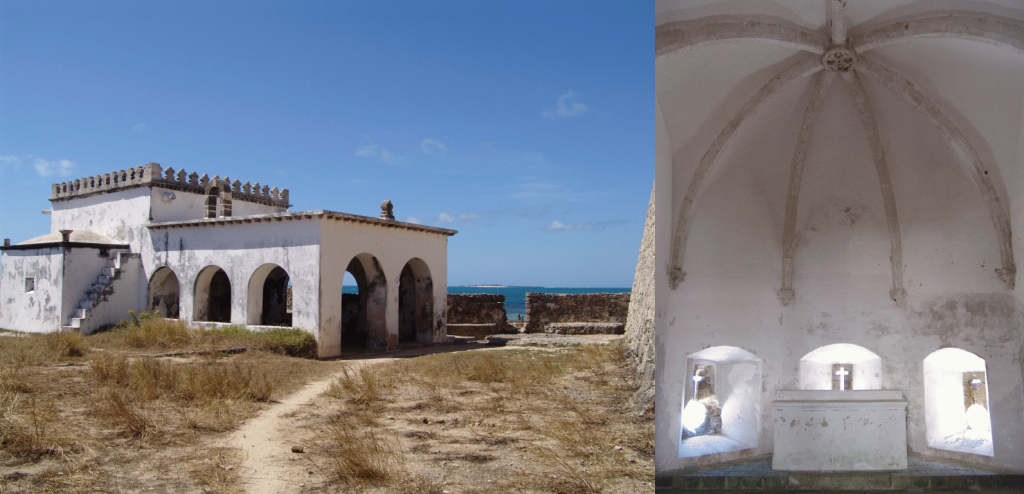
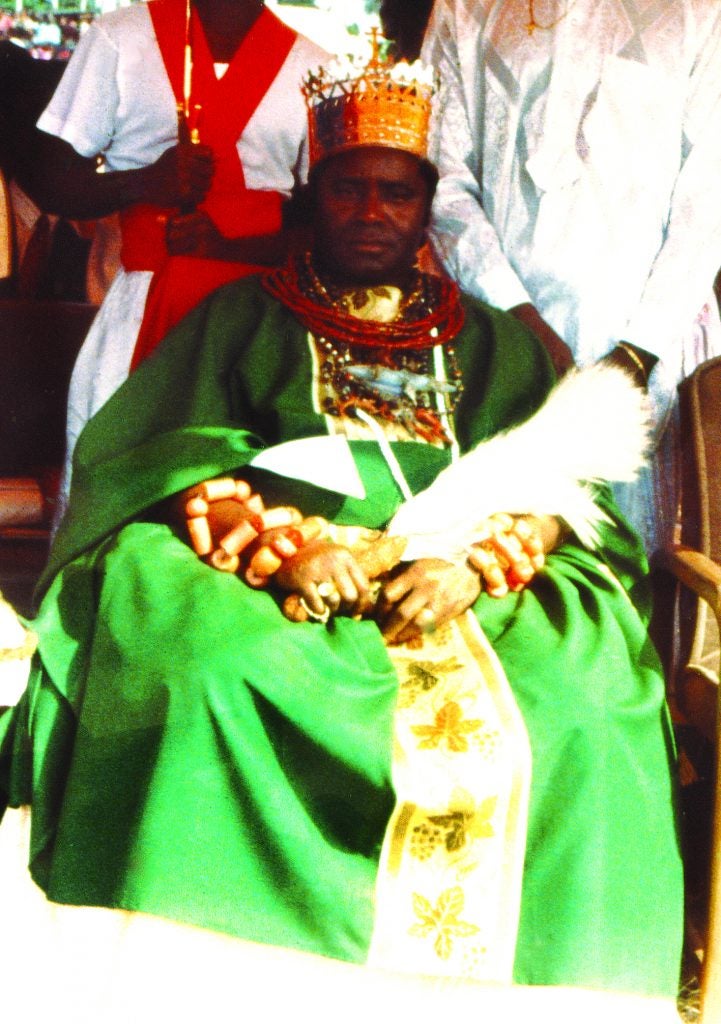
varied. It became important in Egypt, the Sudan, and Ethiopia very early, just as it did in Europe. The rest of Africa, however, remained unaffected. When the Portuguese began to venture down the West African coast in the 15th century, they began a second wave of missionization (Fig. 578), which the French continued in the 18th century. These and other Catholic efforts were, however, geographically disjointed—although West, Central, and southeast Africa were involved, high priestly death rates meant that Christianity ebbed periodically in selected coastal states until African clerics were ordained. Those states where it had the strongest impact had monarchs who had converted (Fig. 579), such as many of the Kongo states, or were areas where the Portuguese or the Dutch created satellite communities.
More intense missionization waited until the 19th century, when Protestants joined Catholics in concerted efforts to convert Africans through both churches and schools. With trade expansion and colonization, evangelization moved inland and resulted in a widespread establishment of Christianity in many regions. African Catholic priests from multiple regions have themselves become missionaries to the United States and other international destinations, while Pentecostal denominations have established megachurch branches in European and American cities.
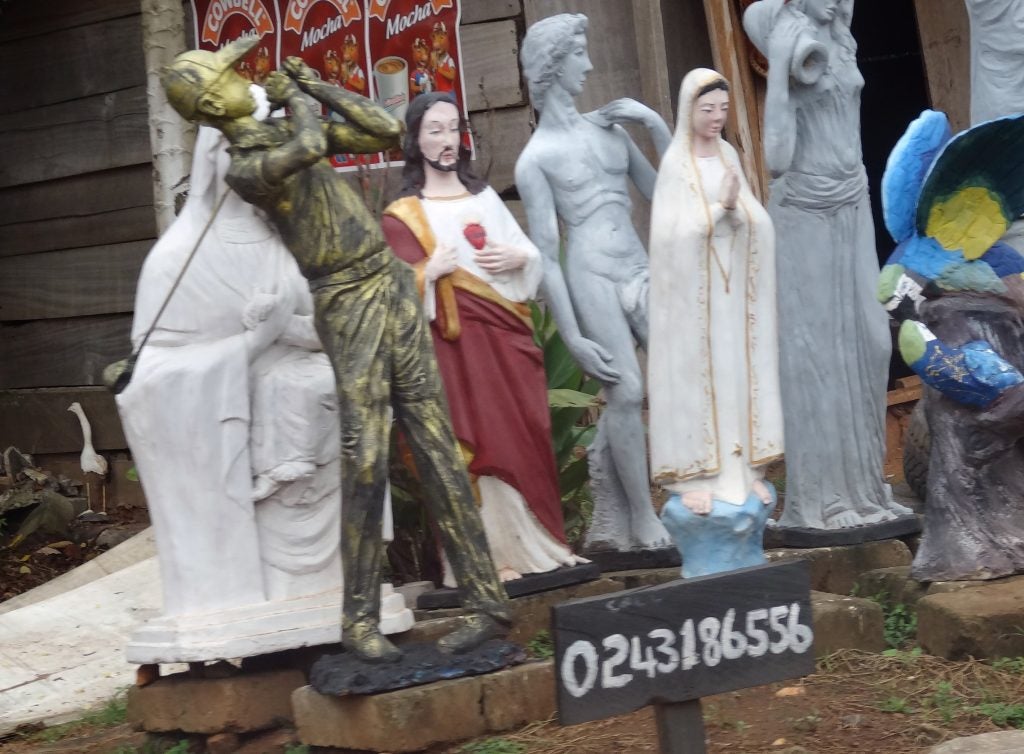
In general, Christianity has had a negative effect on traditional religious art, although household goods and other secular arts may have remained unaffected. Missionaries often encouraged the destruction of objects relating to ritual practices, or collected such objects themselves to display in Europe when fund-raising for their efforts to convert the “heathens.” In Ethiopia, however, Christianity led to the establishment of key art forms that have been central to the art history of the Tigray and Amhara peoples. With a few key exceptions, Christian art elsewhere in Africa has been fairly limited.
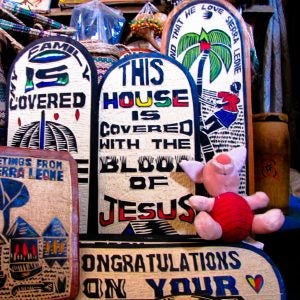
Sometimes it involves statuary produced for churches or devout individuals (Fig. 580), public statements of faith by the latter, or banners, plaques, or paintings made for interior use (Fig. 581). Occasionally, religious references have cropped up in traditional art forms, such as crucifixion scenes as superstructures for Igbo maiden spirit masks. Christian forms and motifs have not, however, replaced older art forms in number and types.
The most visible expression of Christian art is church architecture. Colonists built structures in familiar styles (Fig. 582), often in the stone that was standard in their metropoles, although a novel building material

in most of Africa. Most were designed by Europeans or Americans, but the Anglican Cathedral Church of Christ (Marina) in Lagos was designed by architect and engineer Bagan Benjamin, a “Saro” (a Liberated African who came to Nigeria from Sierra Leone), albeit after a European model. Begun in 1925 and completed in 1956, its simplified neo-Gothic style includes flying buttresses and pointed arches, but lacks the spires that would relieve its visual heaviness. Penned in today by high-rises, it once served as a waterfront focus, soaring above nearby buildings in a statement of colonial Christian dominance.
Catholic churches continued the decorative programs–sculpture, painting, textiles–that it had long commissioned, while Protestants continued to abjure most figurative ornamentation. As the 20th century advanced, locally designed churches became more internationally modern in style, usually abandoning stone in favor of reinforced concrete or cement. Pentecostal Protestant churches range from the modest to the enormous (Fig. 590), the latter stressing streamlined design over decoration.
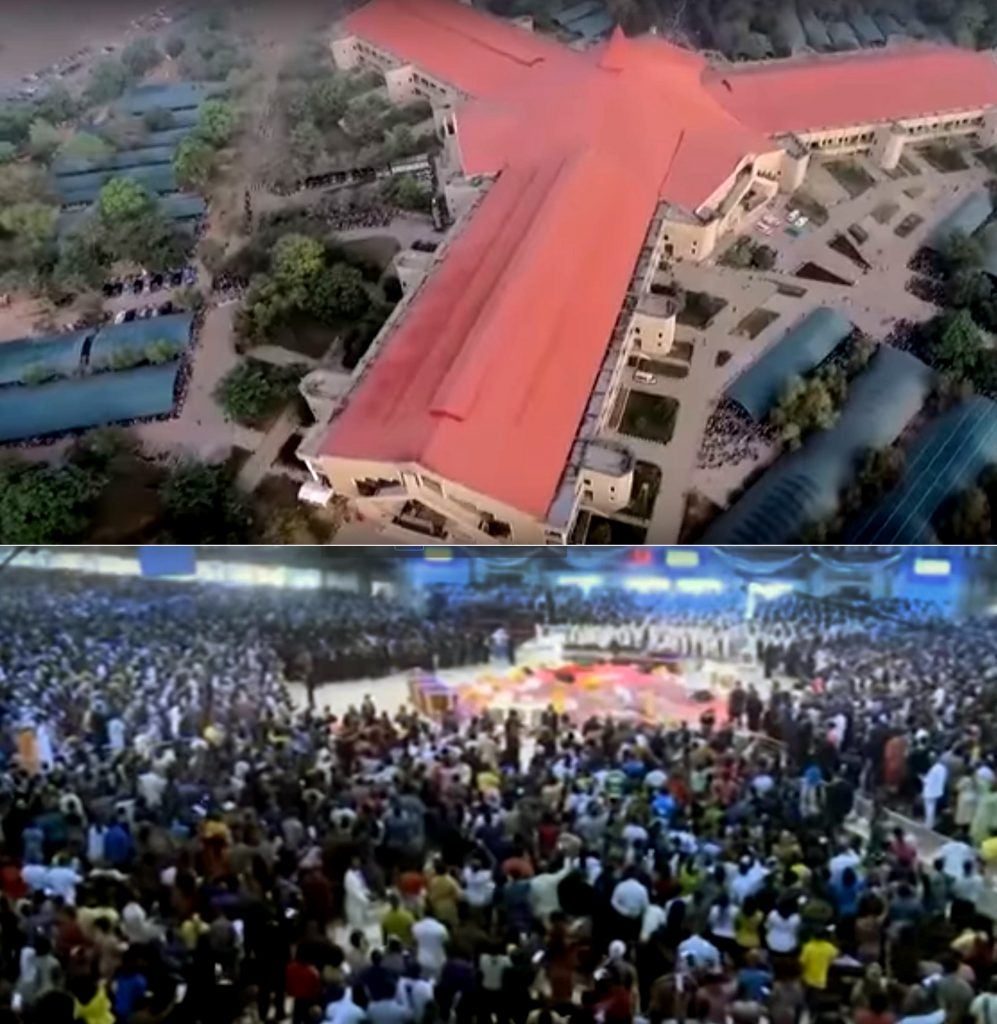
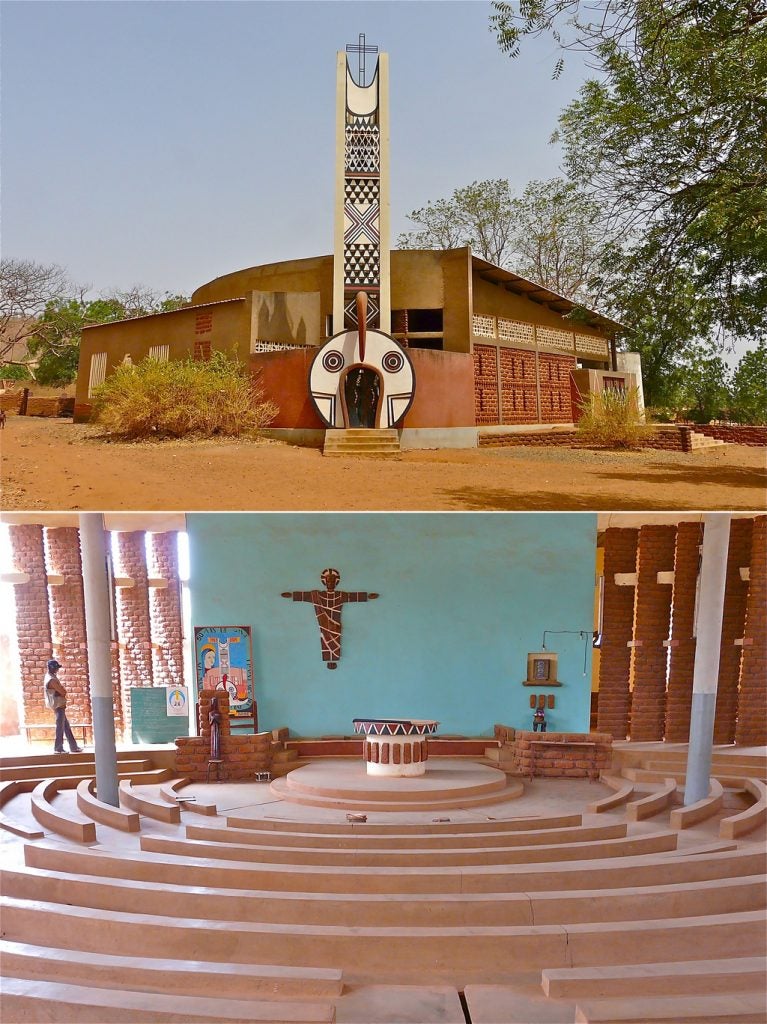
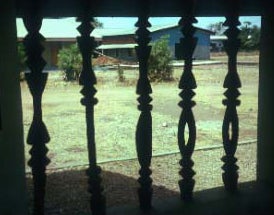
The second half of the 20th century saw foreign missions erect a number of Catholic churches that departed from Western designs. Instead, they co-opted traditional symbols and materials in an effort to indigenize the physical Church (Fig. 591), often involving traditional artists in their construction and decoration (Fig. 592).
Subsequent post-independence architecture tended to adhere to the International Style of sleek concrete architecture, but some artists took directions that were out of the mainstream. Beginning in the 1960s, Demas Nwoko designed and supervised the erection of St. Thomas Aquinas Priory, a chapel complemented by a lounge, school, and refectory for the Dominican order in Ibadan, Nigeria (Fig. 593). Hailed for its originality, its use of cross-shaped lighting is reminiscent of Le Corbusier, but a partial moat, exterior screening elements, and carved wooden interior posts combine to create a distinctly African variety of Modernism, an achievement matched by few other buildings.
Individual missionaries sometimes took the initiative to become more sustained patrons, such as Father Kevin Carroll, a Society of African Missions priest who worked in the Oye-Ekiti region of Western Nigeria. From 1947–54, Carroll led a
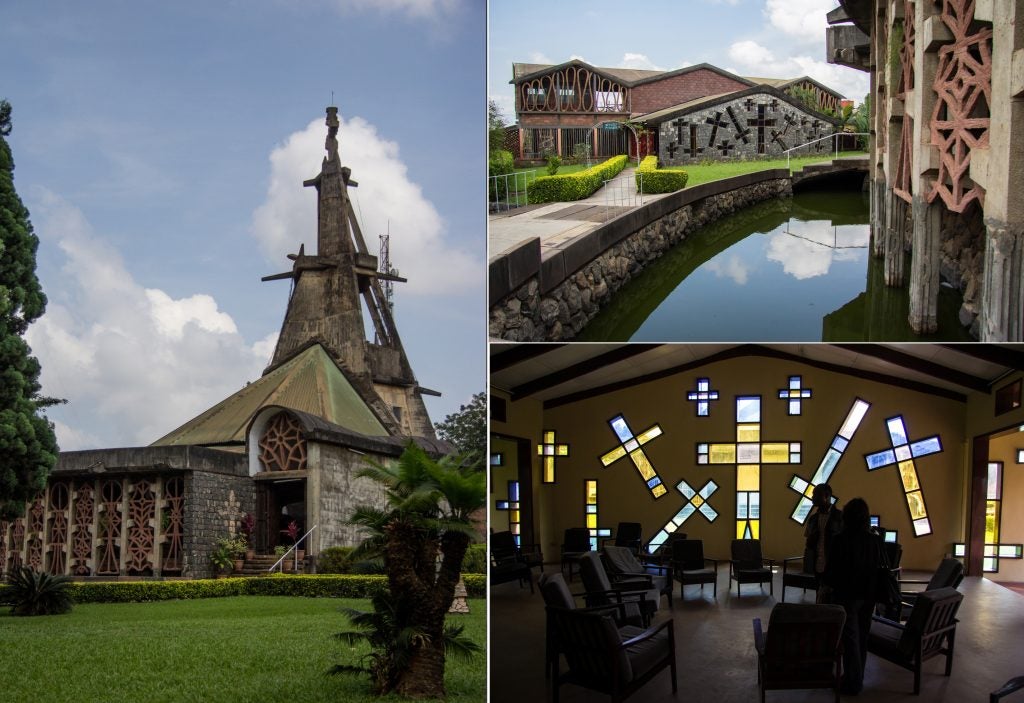
workshop that enlisted traditional Yoruba sculptors–many of whom were Muslim–to carve doors with Christian themes that followed the organization and style of Yoruba palace doors, as well as diverse objects such as baptismal fonts, Stations of the Cross, and Nativity scenes. These cast Biblical characters in familiar Yoruba modes: the Annunciation shows the angel appearing to Mary as she pounds in a mortar, one of the Magi brings his gifts in a kola nut container.
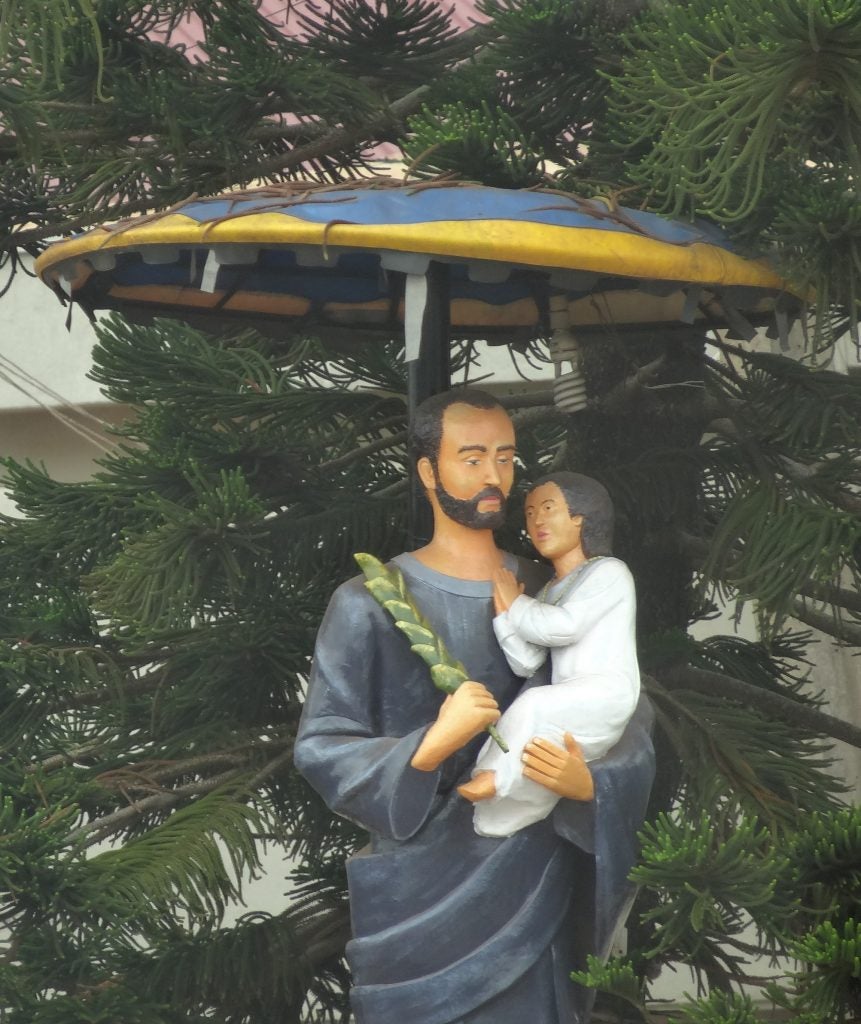
As the century wore on and most Catholic missionaries were replaced by African missionaries, additional churches both incorporated elements that reflected local culture (Fig. 594) and, in an effort to show their international outlook, replicated famous European religious sculpture.
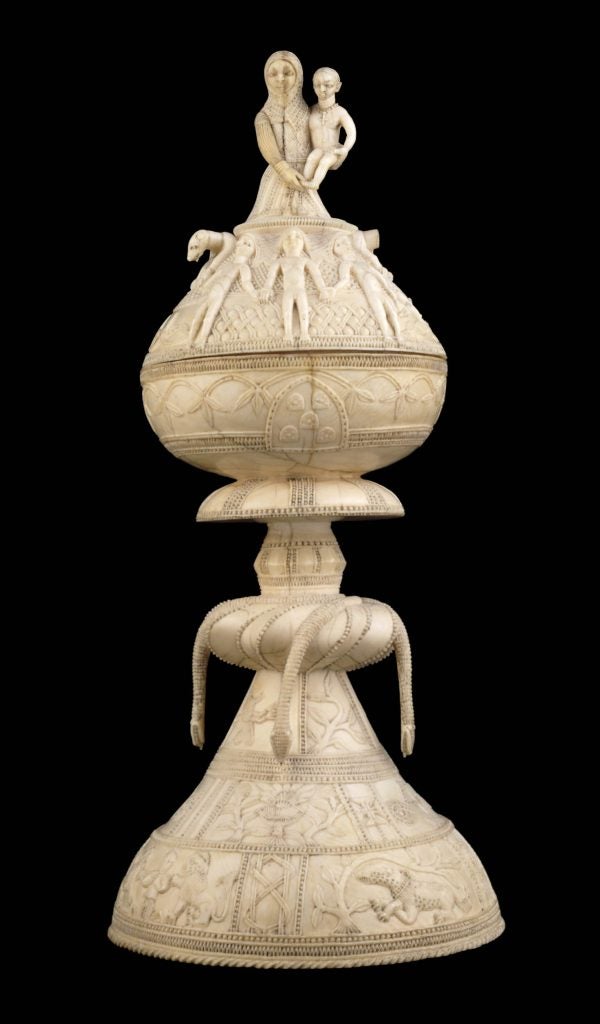
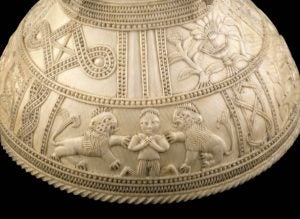
Extant Christian sculpture in Africa dates back to Lalibela reliefs (see below). In West Africa, Christian references first appeared on a number of ivories from Sierra Leone carved for the Portuguese. These delicate objects included several pyxes meant for ecclesiastical use, covered
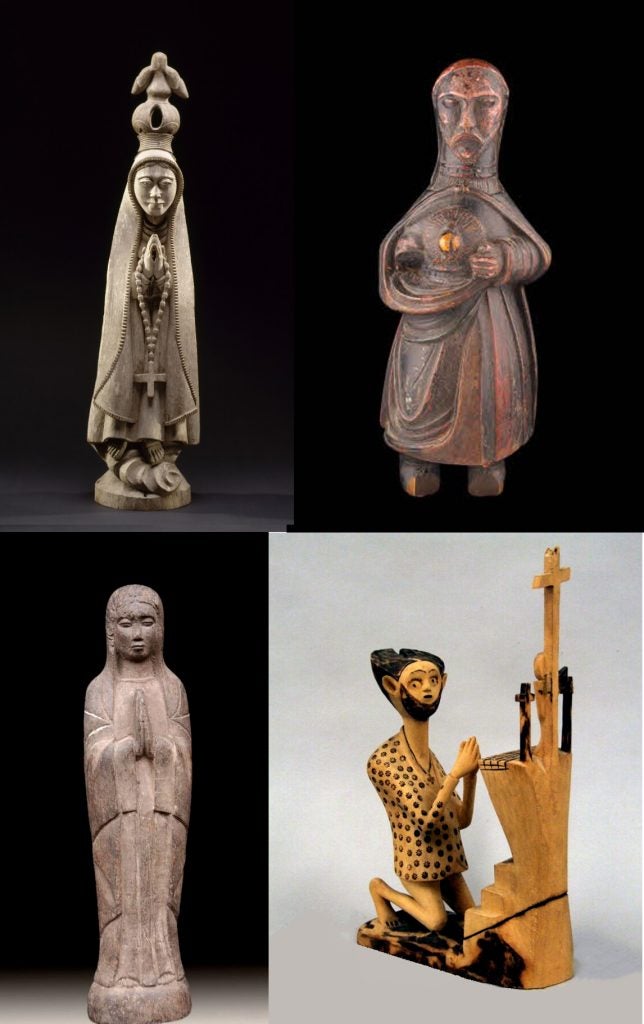
with scenes from the lives of Christ or the Virgin Mary, but even secular items such as saltcellars meant for an aristocratic table might include Christian motifs to demonstrate either a family’s devotion or that of a high-ranking cleric (Figs. 595 and 596). The forms of the objects frequently mimicked European cups, and in some cases–like this–foreign prints were apparently shown to the artists.
Once colonization and intensive missionization began, more sculptors and painters began incorporating Christian missionaries and Biblical subjects in their work, either as local observations or commissioned work (Fig. 597). Sometimes these were totally new inventions that adhered to European representational modes, but at other times interpretations referenced traditional art. Amongst the Ibibio of Nigeria, for example, the form of the traditional girl’s doll was adapted to become that of Christ on the cross (Fig. 598).
As time went on, both Christian urban and academic artists included religious themes in their repertoire. Some of the former, such as Chéri Samba, have critiqued money-mongering preachers in their work. Others, like Almighty God (Kwame Akoto), had personal religious revelations and
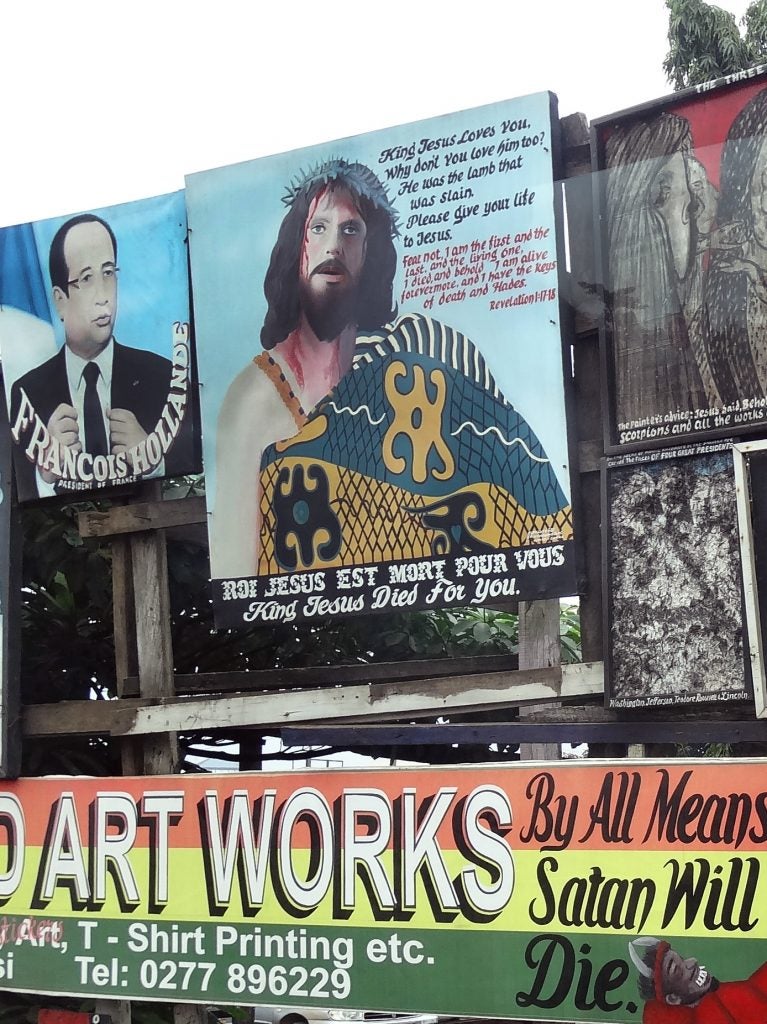
refer to Christianity in paintings that range from depictions of Christ (Fig. 599) to admonitions to stop smoking.
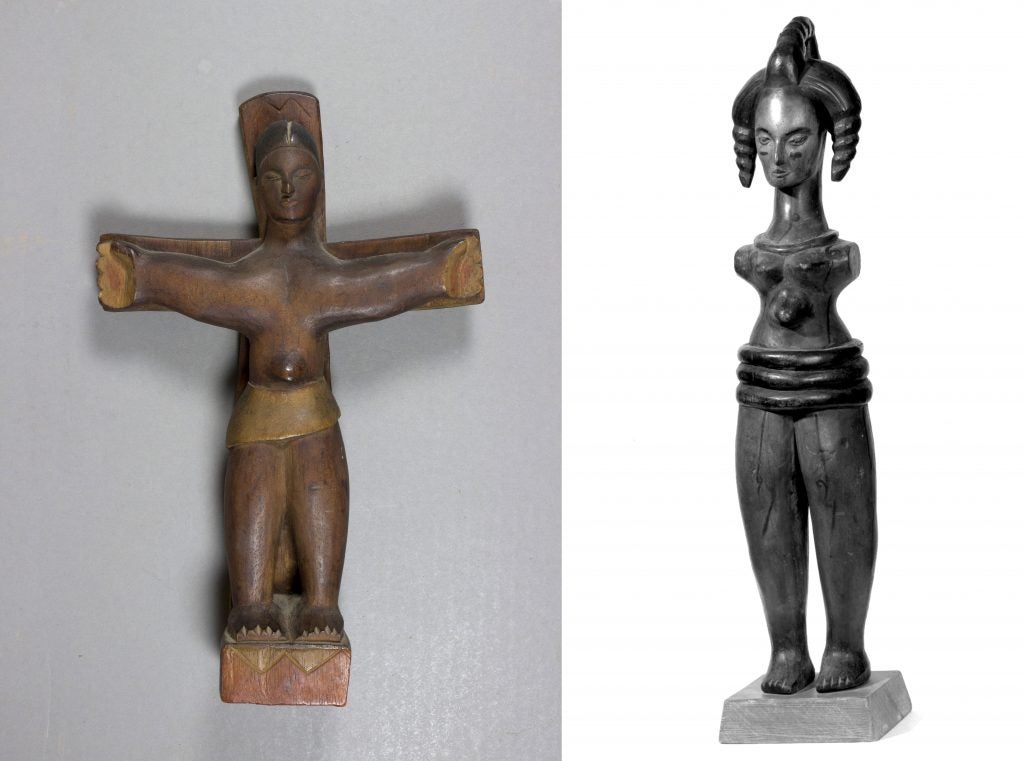
Academic artists such as Bruce Onabrakpeya, who also examines cultural and historical themes, have also addressed Biblical subjects. Onobrakpeya’s linocut 14-print series, Stations of the Cross, creates a sense of immediacy to his Nigerian audience by incorporating local references, as European artists have done for centuries. When Christ meets his mother, she wears the ikele coral circlet and okuku beehive hairstyle of the Benin Kingdom court. Some members of the crowd along the crucifixion’s procession are dressed in Yoruba patterned indigo adire cloth, and the Roman soldiers wear the uniforms of Hausa members of the colonial British police force (Fig. 600), an indictment of both the former oppressors and their agents and a possible coded reference to Nigeria’s divisive legacy during the contemporaneous civil war.
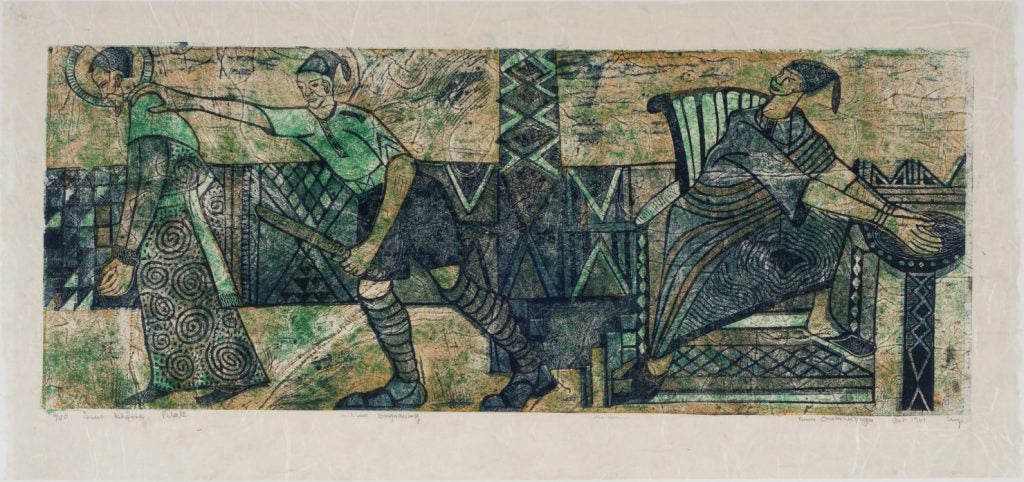
Coptic Christian Art
Egyptian traditions state that St. Mark brought Christianity to Alexandria in the first century CE, and it spread southward in the second century. It became Nubia’s official religion in 580 CE, and was heavily influenced by the Byzantine Empire. Ethiopia, which had had a long-standing relationship with Israel and already had a Jewish segment of the population, apparently housed some Christians by the first and second centuries, and, by the 4th century Frumentius, a Syrian-Greek who was enslaved in Ethiopia’s Axum Kingdom, began to make converts, including the king. Frumentius traveled between Alexandria and Axum, and from the latter, the religion spread quickly as the state faith. Byzantium and the Mediterranean world more generally traded and interacted with both Nubia and Axum, and later with other Ethiopian capitals, and the Christian art of Ethiopia shows the influence of successive trading partners: the Greeks and others from Byzantium, the Italians and Portuguese of the 15th-17th centuries, and even the Indians of the 18th century. Coptic Christianity is distinct from both Catholicism and Eastern Orthodox religions, although it has considerable affinities with both. Ethiopia’s official liturgical tongue is Ge’ez, a Semitic language that is no longer spoken outside church services.
The advent of Islam eventually brought an end to Nubia’s Christian faith with invasions from Egypt that lasted from the 7th century to 1504. At its
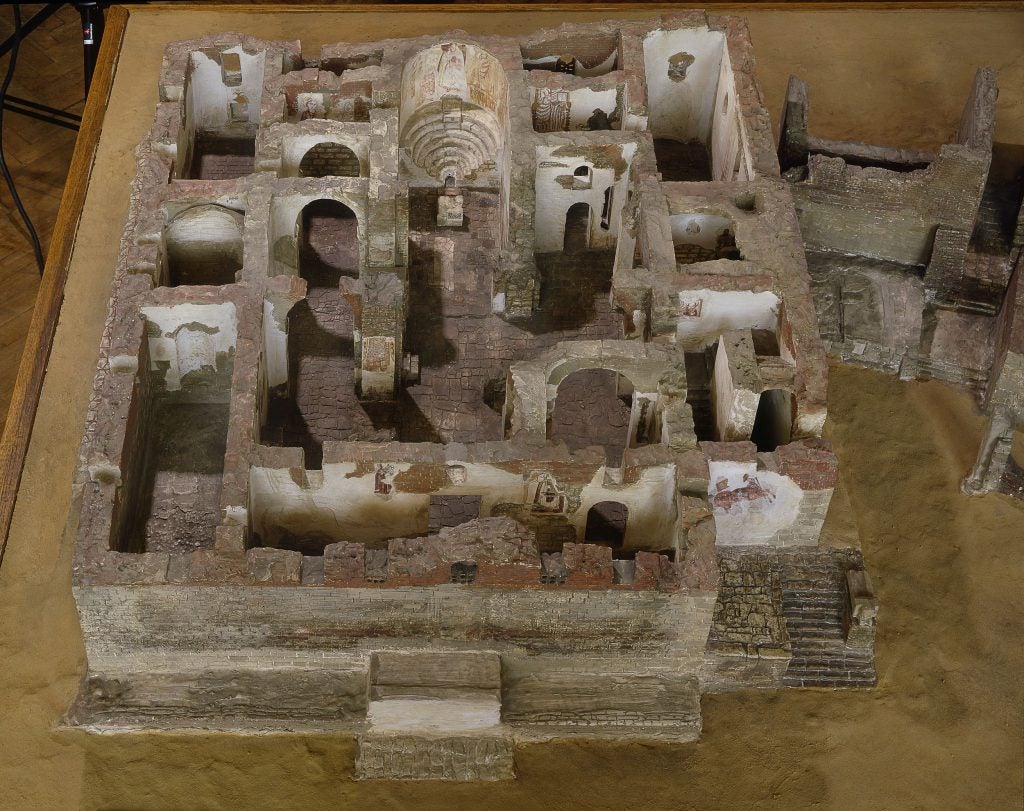
height, however, numerous churches and monasteries were clustered near the Nile in the kingdoms of Alwah, Makuria, and Nobatia. After the Islamic conquest, most fell to ruins, and some were covered by earth and forgotten. While Egypt was planning to build the Aswan Dam along the Nile, archaeologists came to the area to perform emergency excavations, since the resultant dam would produce a lake that would cover a huge area–and did, upon the dam’s 1970 completion. Some structures were relocated, others submerged; still others were unknown until the archeological teams explored the area. One of the surprises occurred in the rich trading town of Faras, a medieval Nubian city now in Sudan and once Nobatia’s capital. Preliminary observation suggested a large mound might be a temple site, but excavations revealed it was the Cathedral of Faras. Built in the early 7th century, subsequent versions were erected on its foundations. The
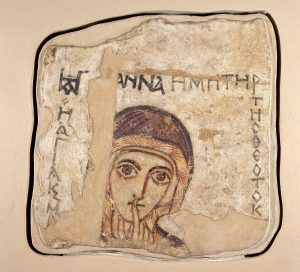
building’s foundation was stone, with its upper levels made of fired brick; its interior included several refurbishments that closed in some of the spaces spanned by vaulting (Fig. 601).
Its frescoed walls were added to until the 14th century and include numerous paintings of Biblical and saints’
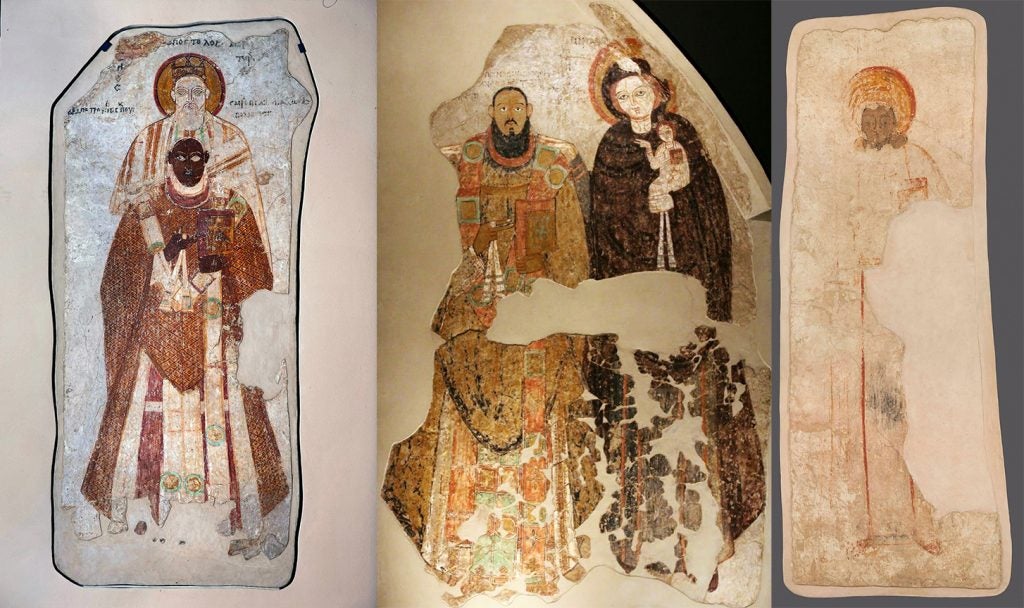
scenes. These follow the style of Byzantine art: backgrounds are plain or simplified, naturalistic anatomy is discarded in favor of flat, elongated robed figures that stress patterning, figures are usually frontal with stylized linear features that emphasize the eyes, long narrow noses, expressive hands, and stylized drapery folds (Fig. 602). Several images show Nubian high-ranking clerics and royals in the protective presence of saints, their tunic textiles following Byzantine fashions; saints are themselves
often dressed more modestly (Fig. 603).
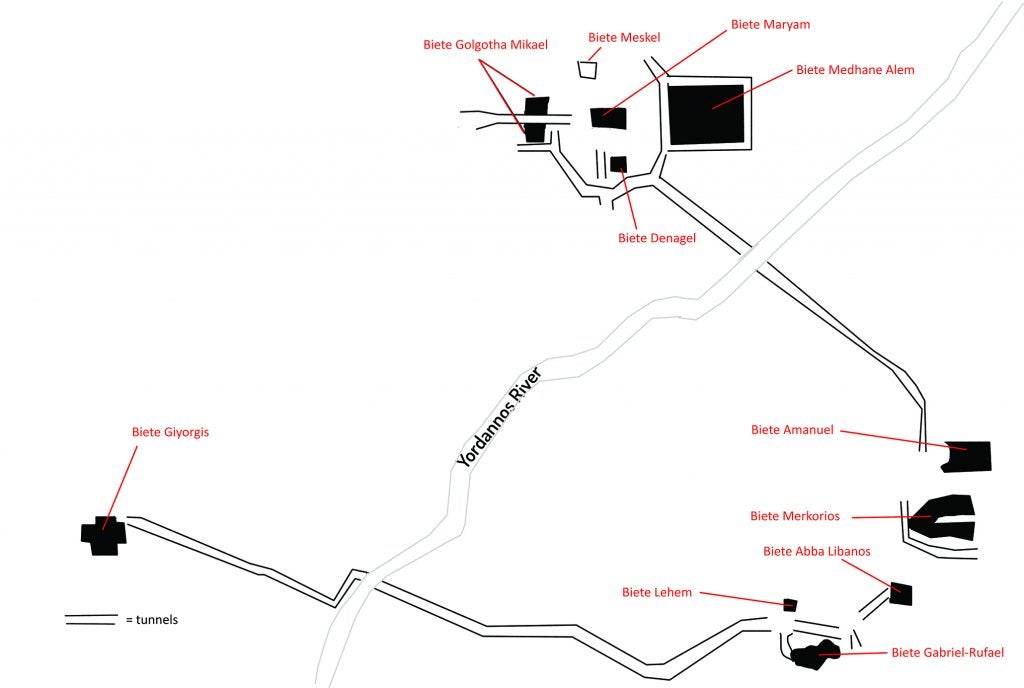
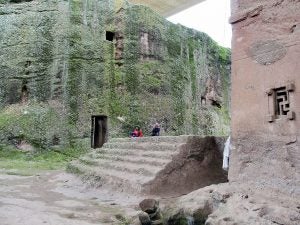
By the 4th century, the ruler of the Axum kingdom in Ethiopia became a Christian convert, and it became a state religion. Additional missionaries spread the religion into the Tigray region, and numerous churches and remote monasteries were built, some in caves and partially cut into the rock. The most spectacular structures are a series of 11 churches said to have been built by Emperor Lalibela in the town now named for him (Fig. 604); angels are said to have worked on the buildings at night, after human workers slept. While some scholars believe the timespan for their construction may have begun several centuries earlier, there is no firm evidence as to how long it continued. A few structures may have first been used as fortresses or palaces, their purpose changing over time, while other areas show abandoned attempts at construction.
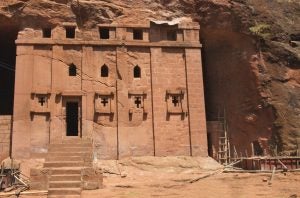
Lalibela, whose reign is encircled in myth-like tales, is said to have had a dream in which he envisioned the churches, which he conceived of as a pilgrimage alternative to Muslim-occupied sites in Jerusalem. His New Jerusalem is divided by a river referred to as the Jordan (Yordannos), and most of the churches on either side are interconnected by underground tunnels (Fig. 605). They are among very few monolithic buildings worldwide; that
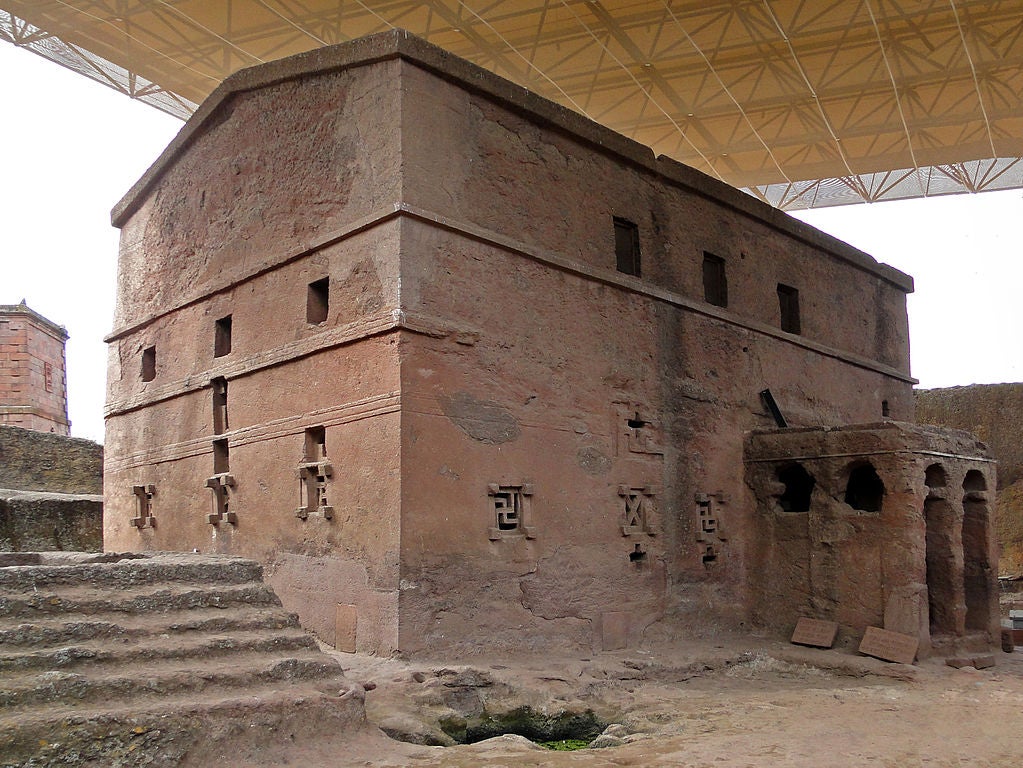
is, each is made of a single huge stone that had to be hollowed out to form an interior. First the surrounding stone had to be gradually removed; when a window was created, it opened the opportunity to tunnel inwards and carve out the interior.
Although all but one church has a rectangular exterior, only some interiors take that shape, while others are cruciform. Imitative architectural forms demonstrate awareness of other buildings. One imitates Axum construction (as the Axum stele did themselves), with projecting mock beams supporting recessed layers of rock and mortar, while others incorporate fake arches and even a dome–neither of which actually performs the function of distributing the thrust of the stone as true arches and domes are able to do. The engineering knowledge to create these massive structures is remarkable, for, while some show repairs, none collapsed upon themselves. Earthquakes and water damage have necessitated a program of restoration, aided by the churches’ status as a UNESCO World Heritage site. They remain the focus of pilgrimages, particularly full at Orthodox Christmas and at Timkat, the Epiphany celebration.
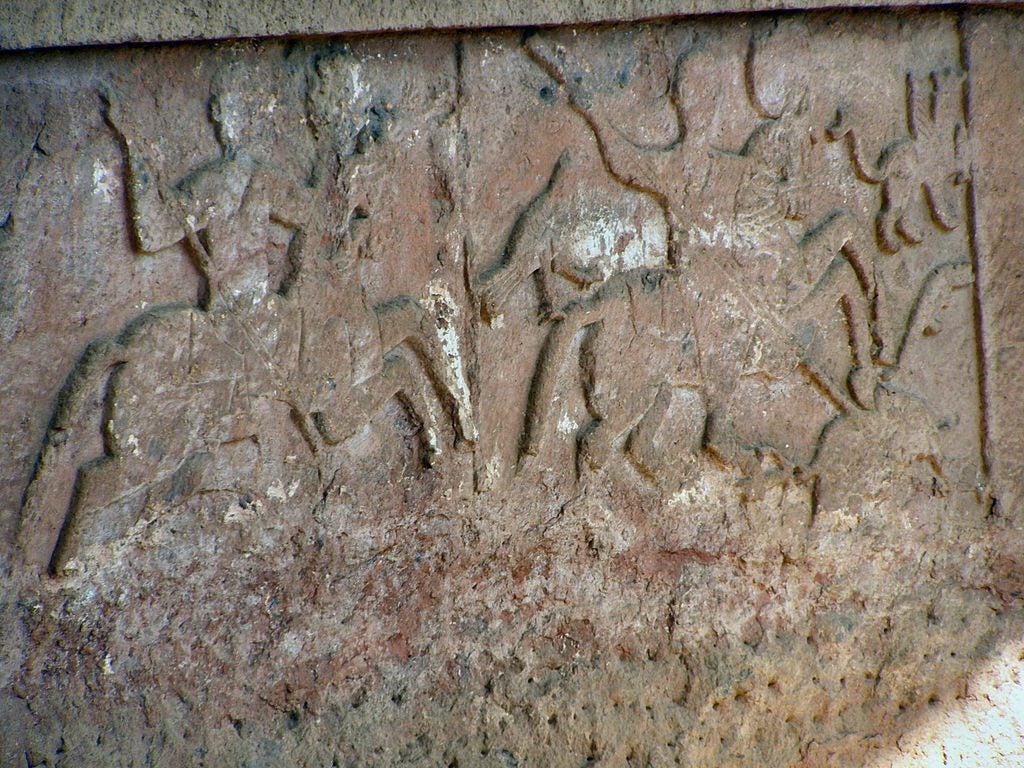
No two churches have identical forms. Many are partially built into the surrounding stone, such as Bete Abba Libanos (House of Abbot Libanos) (Fig. 606), which is attached to the living rock at the roof and floor level. Others, however, are free-standing, such as Biete Maryam, or the House of Mary (Fig. 607).
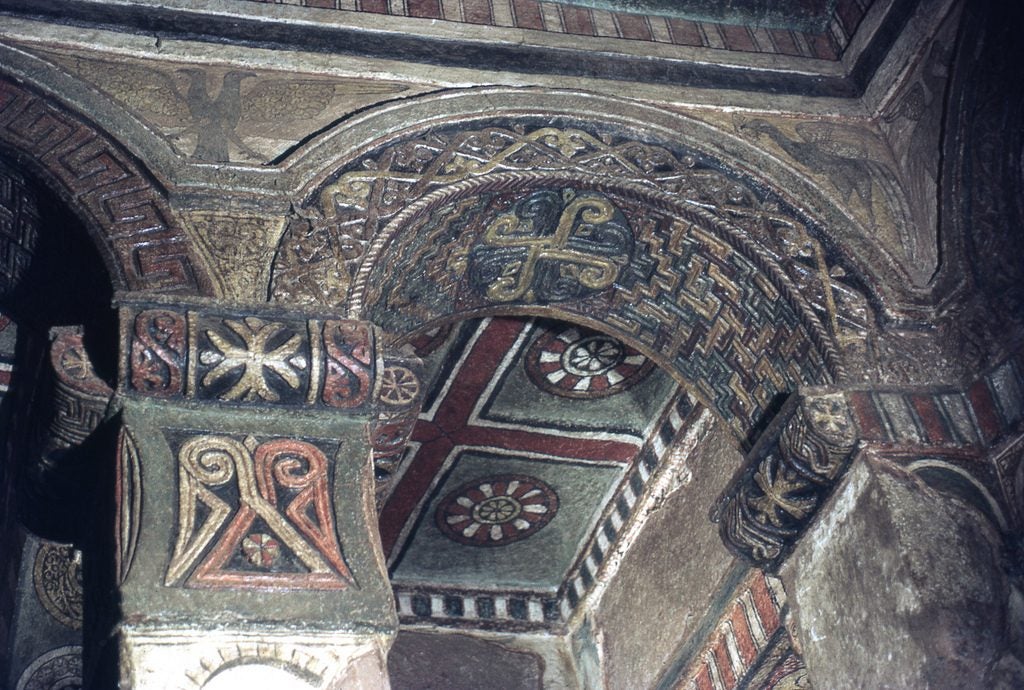
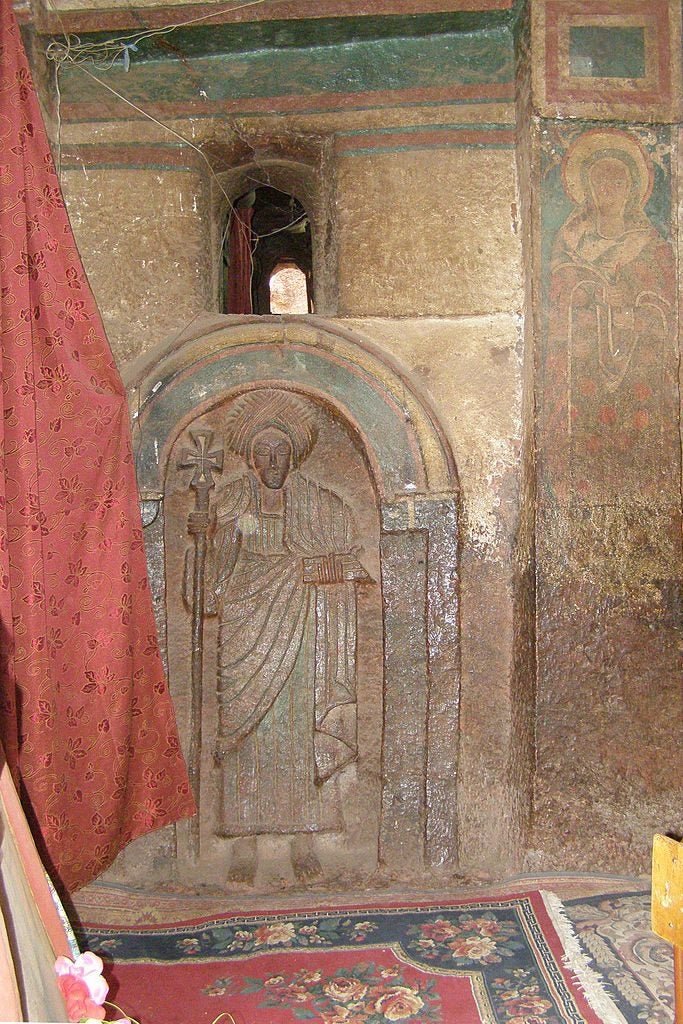
Over its main entrance stands the image of two horsemen hunting a dragon (Fig. 608), a scene that may relate to St. George the dragon killer, for he is the patron saint of Ethiopia and appears frequently in its art. It has three thrusting porch entrances, and, like most of the Lalibela structures, few windows, which produces a dim interior, formerly lit only by candles. Biete Maryam’s interior boasts intricate painted geometric relief carving on its walls and arching openings (Fig. 609). A courtyard pool is meant to help infertile women conceive.
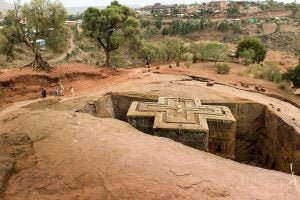
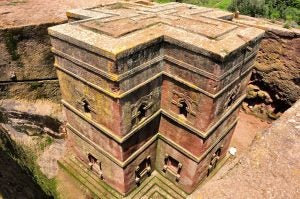
Biete Golgotha, the only Lalibela church barred to women, includes seven large figurative reliefs of saints set within rounded, arched niches (Fig. 610); a panoramic view of its interior can be viewed here. Some of the saints bear halos, while others wear the turbans still seen on priests locally. The rigidly engraved lines that mark the folds of their dress follow Byzantine conventions.
Biete Gyorgis (St. George’s House) is the only isolated church at Lalibela, and can only be accessed through tunnels and inclines. Its distinctive cross-shaped exterior (Figs. 611 and 612) has a flat roof inscribed with concentric crosses, but on its inside, a false dome has been hollowed into the ceiling, again indicating awareness of stone architecture from other parts of the world.
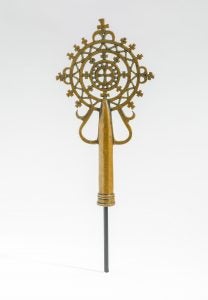
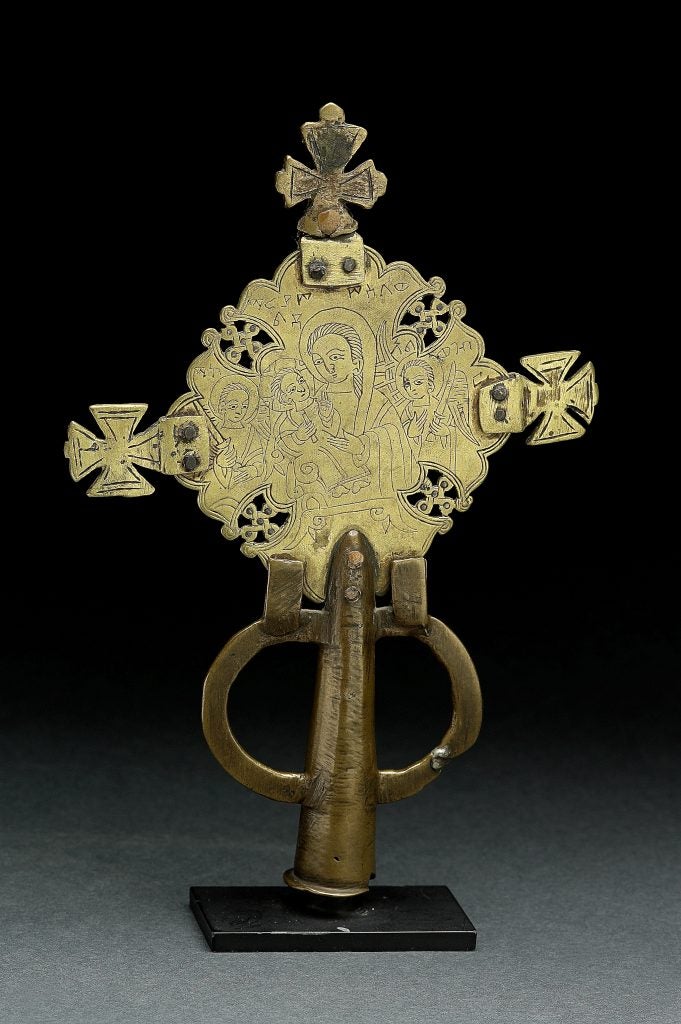
Highland Ethiopia’s adherence to Christianity and its position as a state religion continued among the Amhara who ruled from a series of capitals. A seemingly infinite variety of cross shapes were used liturgically in both wood and metal, many as cast processional crosses mounted on wooden poles. Certain examples display radial symmetry (Fig. 613), while others (Fig. 614) include engraved designs influenced by 15th-century Italian imagery, despite their compressed proportions and simplified linear style. Missionary travel brought numerous Italians to the imperial court at that time, a period when Marian imagery became part of court devotion. At least one Venetian painter, Niccolò Brancaleone, settled in Ethiopia, working ca. 1480-1520, and trained students.
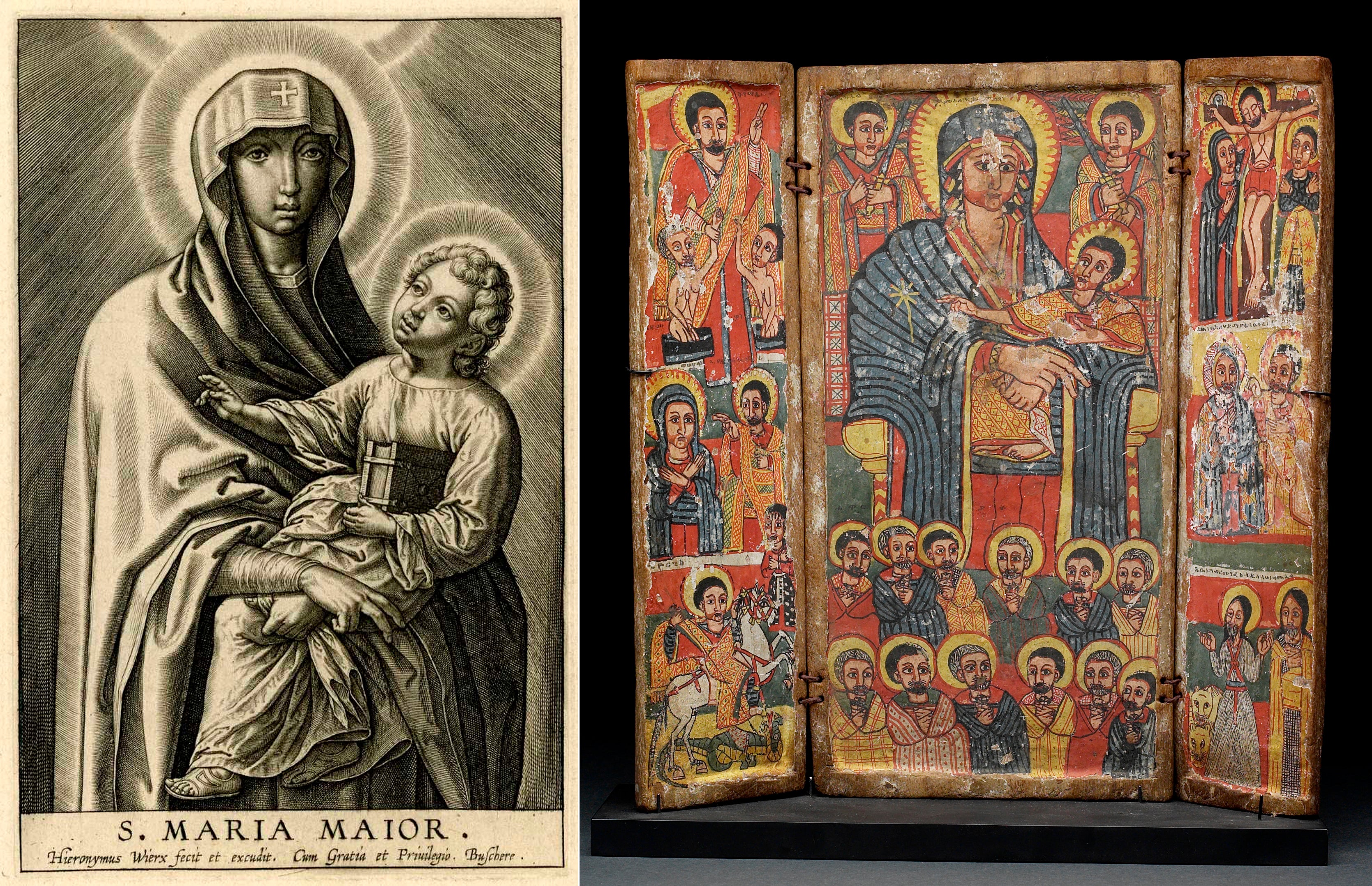
Even without direct contact, prints exposed Ethiopian artists to European religious works, although their influence was primarily compositional an iconographic, rather than stylistic. Early 17th-century Jesuit missionaries circulated prints of the Madonna based on a 6th-century icon from a Roman church felt to have miraculous properties; the painting’s composition had already been copied in many Roman churches. Ethiopian painters added their own touches (Fig. 615), taking a single image and transforming it into a triptych, adding angels and the apostles (shown in hieratic scale) to the main scene, and including St. George, as well as Biblical scenes, on the side panels. This became a stock image for portable devotional imagery–albeit with considerable variation, such as patterned textiles or the occasional inclusion of a cowrie-shell necklace around Christ’s neck. Most noticeably, however, Ethiopian artists rejected the naturalism of the print, changing the head-to-body proportions and favoring unrealistic linear depictions without the shading that provides the illusion of three-dimensionality.
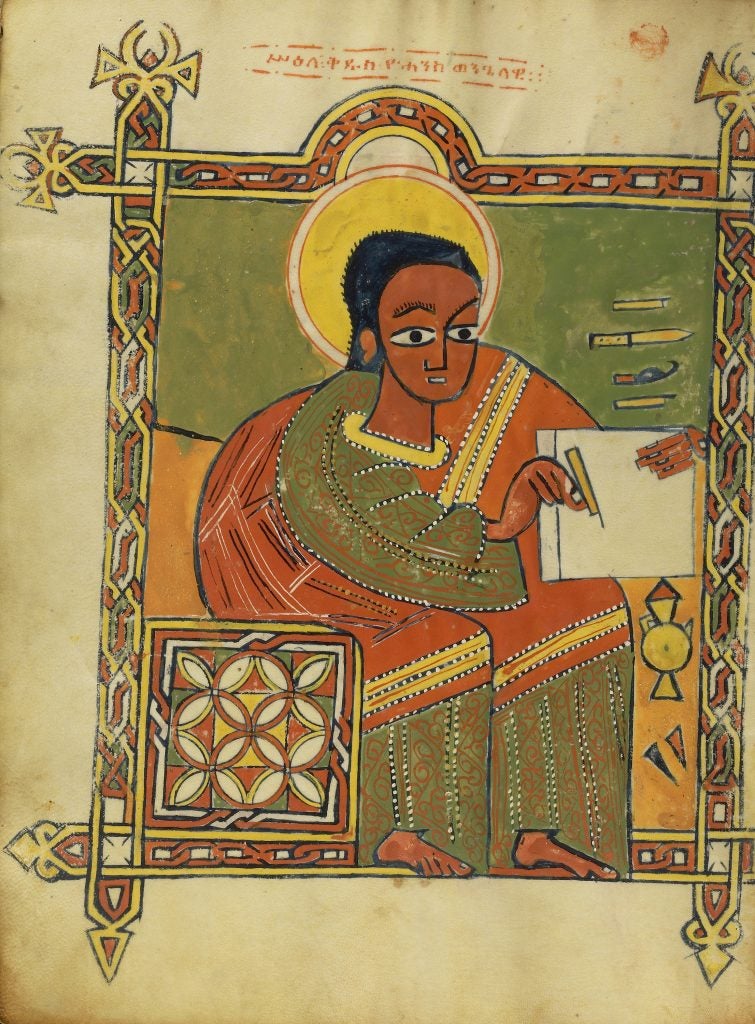
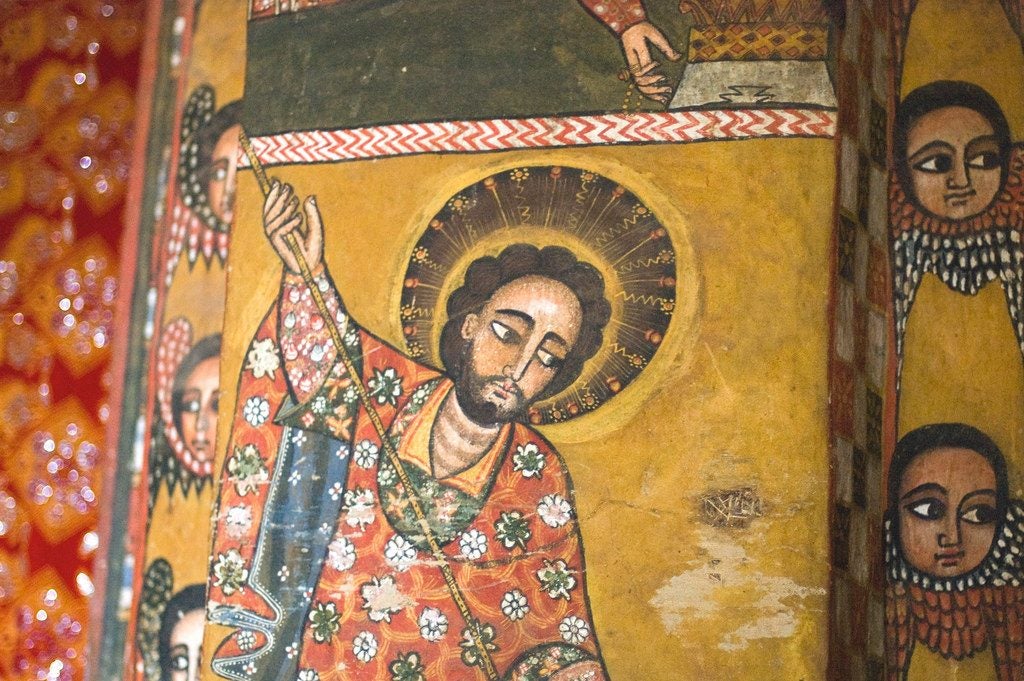
Fresco painting on church and monastery walls and ceilings (Fig. 616), as well as illuminated manuscripts (Fig. 617), provided monk-artists with scope for images that continued to stress decorative borders and patterning with stylized figurative representations.
Subject matter in Ethiopian art remained wholly Christian-oriented until the 1ate 19th century, when some battle scenes were produced; although genre images have entered popular imagery and academically-trained artists create abstract works (Fig. xxx), Christian subject matter still dominates.

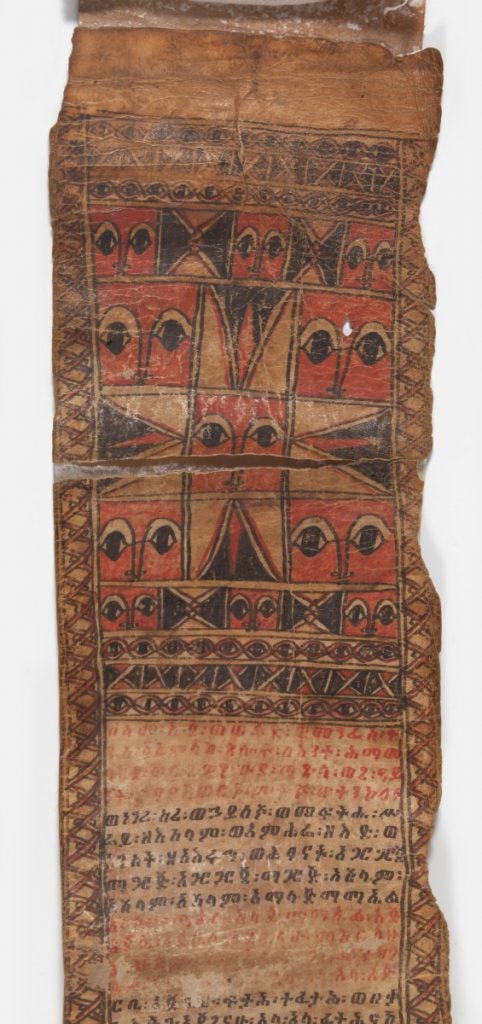
One continuing tradition involves a magico-religious use of art in the form of talismanic scrolls. If an individual falls ill, the family may call in a debtera, an unordained cleric who specializes in curative rituals, despite the fact the official
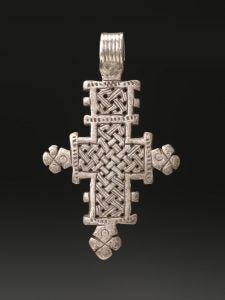
Church frowns on these practices. Beliefs attribute many illnesses to evil spirits, and art is used to help exorcize them by calling on the secret names of God, asking for saints’ intercessions, and compelling demons to obey. The debtera takes a goat or sheep and rubs it against the patient. The animal is then sacrificed, its skin treated until it becomes a parchment scroll that matches the patient’s height (Fig. 618). It is then inscribed with prayers and illuminations specific to the illness. Angels with raised swords populate many scrolls, as do abstract configurations reminiscent of magic
squares (Chapter 4.3) meant to activate divine powers of protection. Some of these emphasize eyes
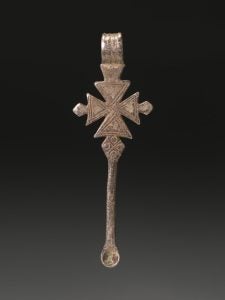
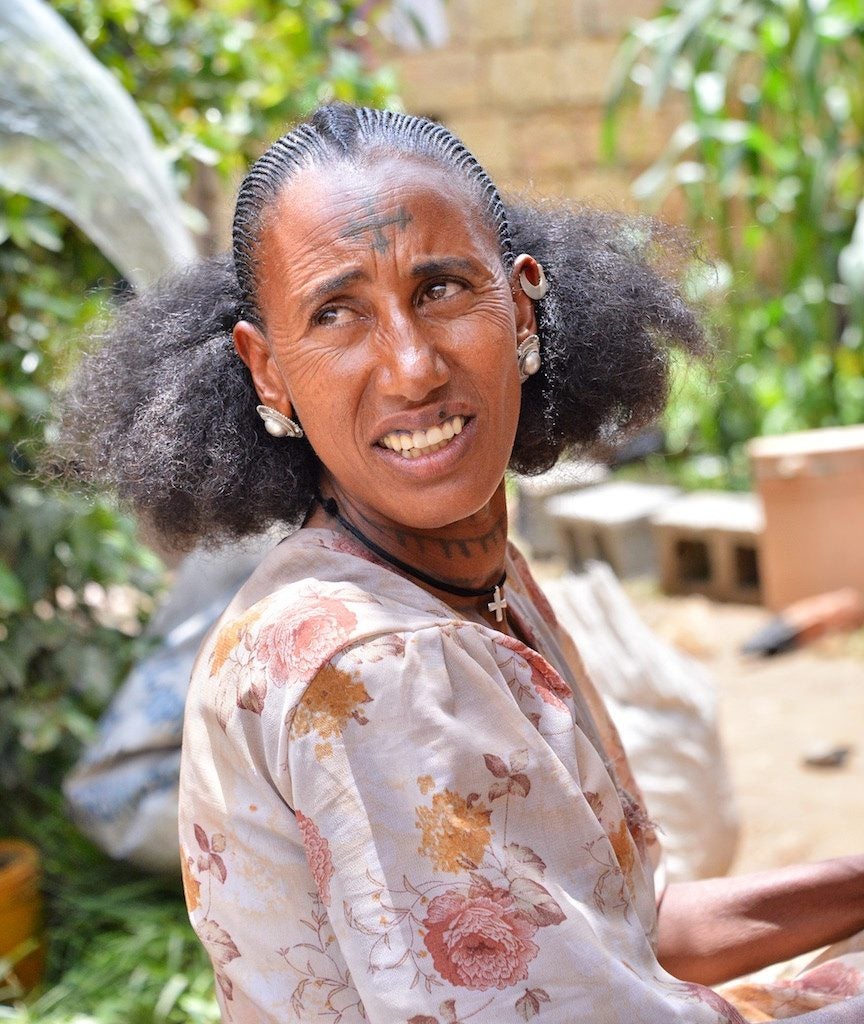
(Fig. 619); the patient and demon look at each other until the latter is entrapped and expelled. After healing, the scroll is rolled up and placed in a leather container, worn around the former patient’s neck.
The many varieties of crosses still show up on Ethiopian jewelry, worn as necklaces by women (Fig. 620), but also appearing on mundane articles, such as implements to clean ear wax (Fig. 621). This Christian symbol acts not only as a symbol of piety, but a motif that offers protection. It appears on the embroidery of women’s white gowns, and even as facial tattoos (Fig. 622).
Further Reading
Akinola, Olatubosun. “Influences of Catholic Mission on Yoruba woodcarving.” In Christoph Elsas and Hans-Hermann Münkner, eds. Selected essays on the occasion of the 90th anniversary of Ernst Dammann, pp. 78-82. Berlin: Verlag Dietrich Reimer, 1994.
Appleyard, Jed. Ethiopian manuscripts. London: Jed Press, 1993.
Bassey, Nnimmo. “Demas Nwoko’s architecture.” In Udechukwu, Obiora, ed. Ezumeezu: essays on Nigerian art & architecture: a Festschrift in honour of Demas Nwoko, pp. 165-178. Glassboro, NJ: Goldline & Jacobs Pub., 2012.
Carroll, Kevin. Yoruba religious carving: pagan & Christian sculpture in Nigeria & Dahomey. New York: Praeger, 1967.
Chojnacki, Stanislaw. Ethiopian crosses: a cultural history and chronology. Milan: Skira, 2006.
Curnow, Kathy. “The Afro-Portuguese Ivories: Classification and Stylistic Analysis of a Hybrid Art Form.” Ph.D. dissertation, Indiana University, 1983.
Finneran, Niall. “Built by Angels? Towards a Buildings Archaeology Context for the Rock-Hewn Medieval Churches of Ethiopia.” World Archaeology 41 (3, 2009): 415-29.
Gnisci, Jacopo. “Crosses from Ethiopia at the Dallas Museum of Art: an overview.” African Arts 51 (4, 2018): 48-55.
Godlewski, Włodzimierz. “Some remarks on the Faras Cathedral and its painting.” Journal of Coptic Studies 2 (1992): 99-116.
Godwin, John and Gillian Hopwood. The Architecture of Demas Nwoko. Lagos: Farafina, 2007.
Heldman, Marilyn Eiseman. “Architectural symbolism, sacred geography and the Ethiopian Church.” Journal of Religion in Africa 22 (3, 1992): 222-241.
Mercier, Jacques. Ethiopian magic scrolls. New York: G. Braziller, 1979.
Quarcoopome, Nii O., ed. Through African eyes: the European in African art, 1500 to present. Detroit: Detroit Institute of Arts, 2010.
Ross, Doran H. “The Art of Almighty God.” African Arts 47 (2, 2014): 8-27.
Silverman, Raymond Aaron, ed. Ethiopia: traditions of creativity. East Lansing: Michigan State University Museum/Seattle: University of Washington Press, 1999.
Kongo Catholicism

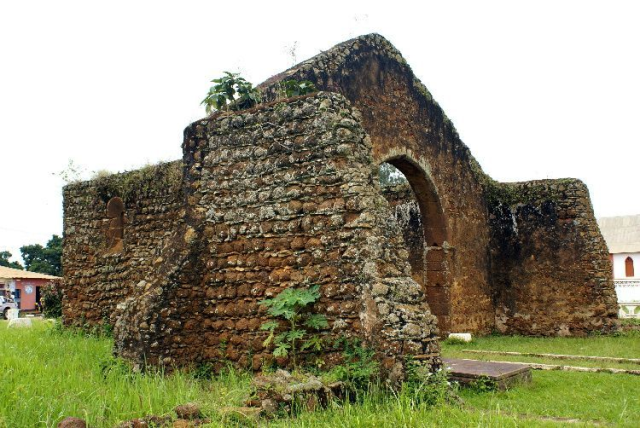
The Kongo region in Angola, Democratic Republic of Congo and the Republic of Congo felt the impact of European missionizing in the late 15th century, eight years after the Portuguese first reached the coast of Central Africa. Quickly, the Kongo ruler and many members of the royal family and court were baptized, and later the name of the capital city, Mbanza Kongo, was recast as São Salvador.
The Portuguese built a small church dedicated to the “Holy Saviour of Congo” in 1591, which was later rebuilt and expanded into a white-washed stone cathedral (Fig. 623). Many churches were erected over royal cemeteries, although Christian burials in and outside churches remained elite privileges. Royal chapels within churches became sites that allowed ancestral cults within an approved context.
In 1509, the first Christian monarch’s son, Affonso I, ascended the throne after a fierce battle with a rival half-brother–a battle in which he stated that St. James led his troops to victory. After his installation, adherence to Christianity intensified for all those who sought his favor. He quickly commanded provincial rulers to erect a church and a monumental cross in their local capital’s public plaza, overt statements of a state religion. Affonso had been mission-trained and corresponded with the Pope, and sent one of his sons to Portugal, where he entered the priesthood and became the first Catholic bishop from sub-Saharan Africa. Affonso ordered nkisi and other traditional religious items in the capital destroyed, but the church he championed included syncretic elements that overlapped traditional religious belief and seem to have made Christianity more acceptable. Kongo religion’s High God, Nzambi a Mpungo, is considered the Creator and was conflated with the Christian God. The shape of the cross itself had strong internal meaning (see Chapter 3.5). Strong beliefs in the powers of ancestors and the spirits of the dead transferred to those of saints. While various orders of European missionaries continued to visit the Kongo kingdoms over the centuries, they were supplemented by local clergy and, more frequently, by elite lay teacher-ministers known as mestres (“masters”). While everyone in the kingdom was certainly not a Christian, and many Christians also practiced elements of traditional religion, Christianity had a broad impact, particularly among the aristocracy.
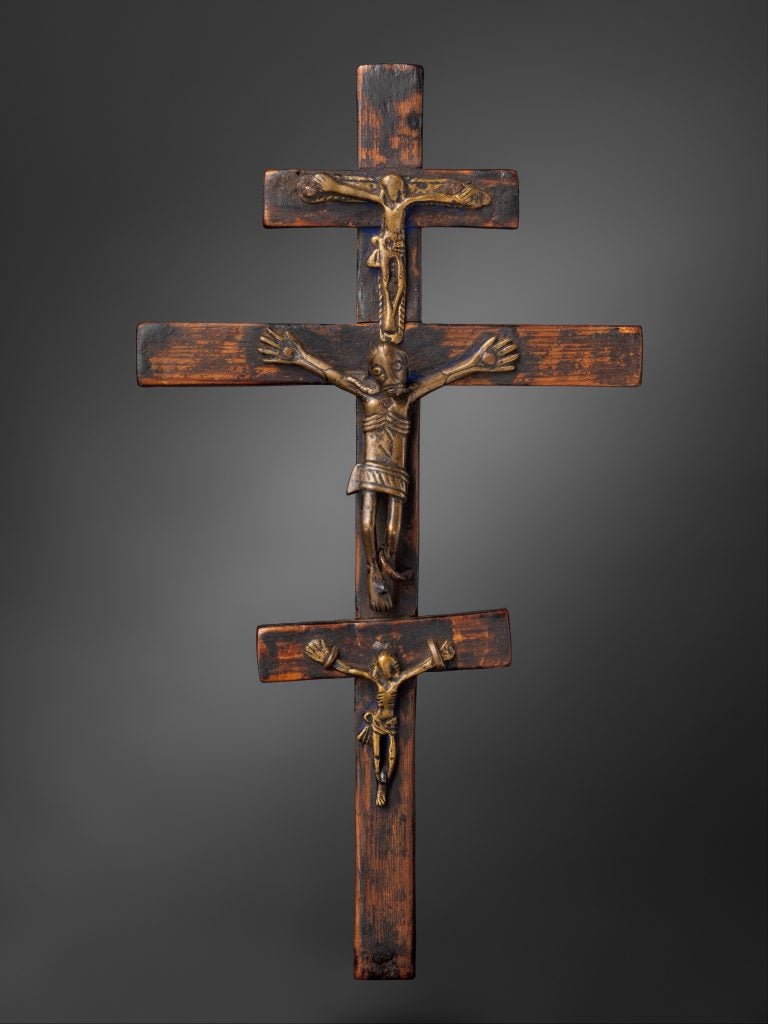
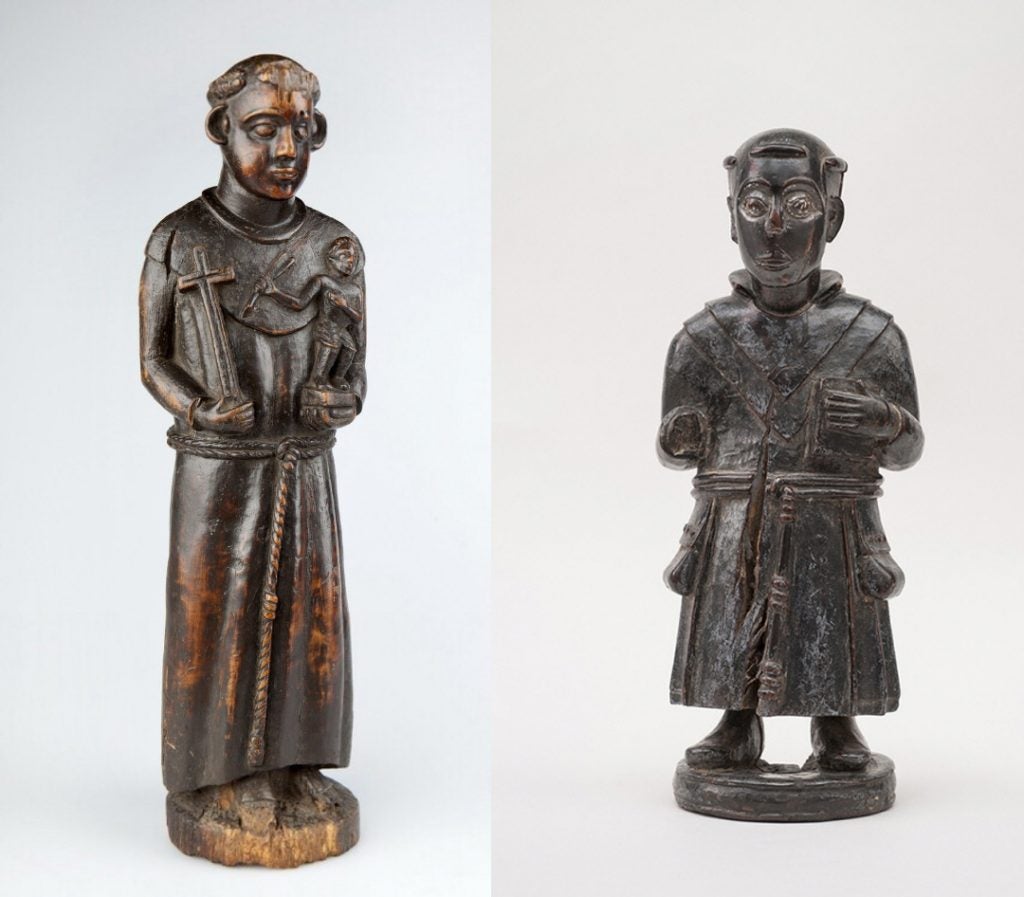
Over the centuries, missionaries imported many crucifixes, but Kongo artists supplemented these with local cast-brass or brass-on-wood examples (Fig. 624). Although museums date these works, it is difficult to distinguish their dates of origin with certainty. Some are closer to European models than others, with more naturalistic head-to-body proportions and accurate anatomy (upper left, Fig. 624). Others enlarge the head, depict Christ’s eyes through a coffee-bean abstraction, transform His projecting ribs into a kind of scarification, and enlarge and flatten His hands and feet. Even those figures, however, almost always tilt the head of Christ in the fashion of European imagery. Additional figures–saints? angels? supplicants?–often occupy extensions of the crucifix, its base often bearing an abstracted figure of the mourning Virgin. One example (Fig. 625) includes the additional crucifixes of the thieves executed next to Christ by stacking them above and below his portrayal, rather than flanking him. He remains considerably larger than them, an instance of local hieratic scale trumping naturalism.
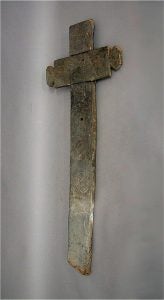

Statues of saints and the Madonna also appeared in Kongo art, with the Portuguese Saint Anthony of Padua prominently featured (Fig. 626). Born in Portugal, the saint’s appeal was probably boosted by those missionaries who were themselves Portuguese. A royal church named after the saint stood in the Kongo capital, and an aristocratic religious confraternity–a non-clerical organization that organized members’ burials, participated in saints’ day processions, staged devotional performances, and promoted charitable acts–also bore his name; it was one of six confraternities in the late 16th-century capital. St. Anthony’s popularity in the Kongo Kingdom was probably less due to his association with finding lost objects and securing husbands for maidens than it was with his power to bring children to barren women, relating as it does to a critical cultural desire. In European art, St. Anthony is often depicted with a lily that represents purity, with a Bible, or with the Christ Child seated on a Bible he holds. In Kongo art, this last-mentioned motif sometimes depicts Christ sitting or standing on a Kongo box throne, holding a flywhisk as a mark of kingship. In the 18th century, St. Anthony took on additional political meaning. The unified Kongo Kingdom had broken down in the 17th century, with civil wars resulting in independent states. A royal woman, known by her baptismal name as Dona Beatriz (ca. 1684-
1706), joined a Kongo group who went to settle in the old royal capital, which had been abandoned. Subject to visions, she referred to herself as the reincarnation of Jesus Christ and created a variation of Catholicism called Antonianism, whose goal was to recreate a unified and Christian Kongo Kingdom under her leadership. As her followers grew, established regional monarchs grew uneasy. She was captured, tried, and convicted of witchcraft, followed by execution.
The association of Christian symbols with political and healing powers continued, even in those
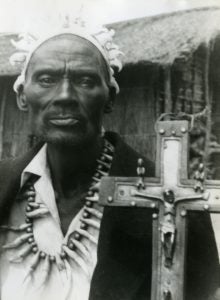
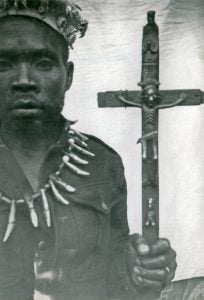
eras where Catholic influence waned. Some aristocrats were buried with cross-shaped markers (Fig. 627). In other areas, rulers or distinguished chiefs held staffs of office that might include a cross or a saint’s figure (Fig. 628). These originated as a badge of office for the mestres, and were called santu-spilitu, a localized term for the Latin phrase for the Holy Spirit. Topped by a cross, they could be inserted into the ground
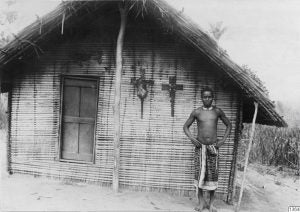
during judicial proceedings, act as an envoy’s badge of identification, or mark the site of ritual activity.
Both civil authorities and ritual specialists might own crucifixes as badges of power or
healing (Figs. 629 and 630), alongside more traditional forms of nkisi (see Chapter 3.5). Other cross forms, sometimes known as santu, became associated with good fortune in hunting (Figs. 631). These are sometimes attached to nkisi bundles filled with additional medicines. Their forms are not identical to that of a common Christian cross; they often have cut-outs, notches, or additional
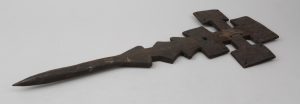
projections (see Figs. 632 and 633). In the early 20th century, they were said to have been blessed by a priest before a hunting expedition, then a few drops of the prey’s blood would be dripped onto the hole in its middle.
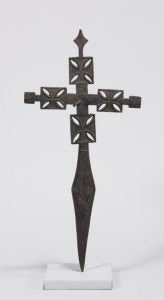
Although the 19th century and colonialism saw the conclusion or alteration of many centuries-old Kongo Christian practices, new missionary orders emerged from the Catholic “motherlands” of Belgium, Portugal, and France, as did Protestant denominations that abjured statuary and crucifixes. Many churches of varied origins stand in the Kongo territories of the Republic of Congo, Angola, and the Democratic Republic of Congo today, including Mormon temples and both small and gigantic Pentecostal structures, Catholicism remains the dominant sect, professed by at least half of the population of the three countries. While some earlier churches are still in use, others are contemporary buildings that reflect changing tastes (Fig. 634).
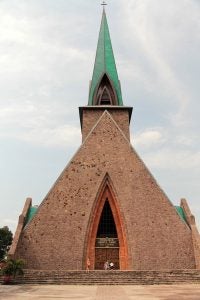
Further Reading
Felix, Marc Leo, et al. Gangguo Wangguo de yi shu = Kongo Kingdom art: from ritual to cutting edge. Xianggang: Wen zu yi shu yu wen hua you xian gong si, 2003.
Fromont, Cécile. The art of conversion: Christian visual culture in the Kingdom of Kongo. Chapel Hill, NC: University of North Carolina Press, 2014.
Heimlich, Gregory. “The Kongo cross across centuries.” African Arts 49 (3, 2016): 22-31.
Heywood, Linda M. and John K. Thornton. Central Africans, Atlantic Creoles, and the foundation of the Americas, 1585-1660. New York : Cambridge University Press, 2007.
LaGamma, Alisa, et. al. Kongo: Power and Majesty. New York: Metropolitan Museum of Art, 2015.
Massing, Jean Michel. “Crosses and Hunting Charms: Polysemy in Bakongo Religion.” In Encompassing the Globe: Portugal and the World in the 16th and 17th Centuries: Essays, ed. Jay A. Levenson, 87-96. Washington, DC: Arthur M. Sackler Gallery, Smithsonian Institution.
Mello e Souza, Marina. “Central African Crucifixes: A Study of Symbolic Translations.” In Encompassing the Globe: Portugal and the World in the 16th and 17th Centuries: Essays, ed. Jay A. Levenson, 97-101. Washington, DC: Arthur M. Sackler Gallery, Smithsonian Institution.
Slenes, Robert W. Saint Anthony at the crossroads in Kongo and Brazil: “creolization” and identity politics in the black south Atlantic, ca. 1700-1850. Trenton, NJ: Africa World Press, 2008.
Thornton, John K. “Afro-Christian Syncretism in the Kingdom of Kongo.” Journal of African History 54 (1, 2013): 53-77.
Thornton, John K. The Kongolese Saint Anthony: Dona Beatriz Kimpa Vita and the Antonian movement, 1684-1706. New York : Cambridge University Press, 1998.
Volper, Julien. Du Jourdain au Congo, art et christianisme en Afrique centrale = Crossing rivers: from the Jordan to the Congo: art and Christianity in Central Africa. Paris: Flammarion, 2016.

